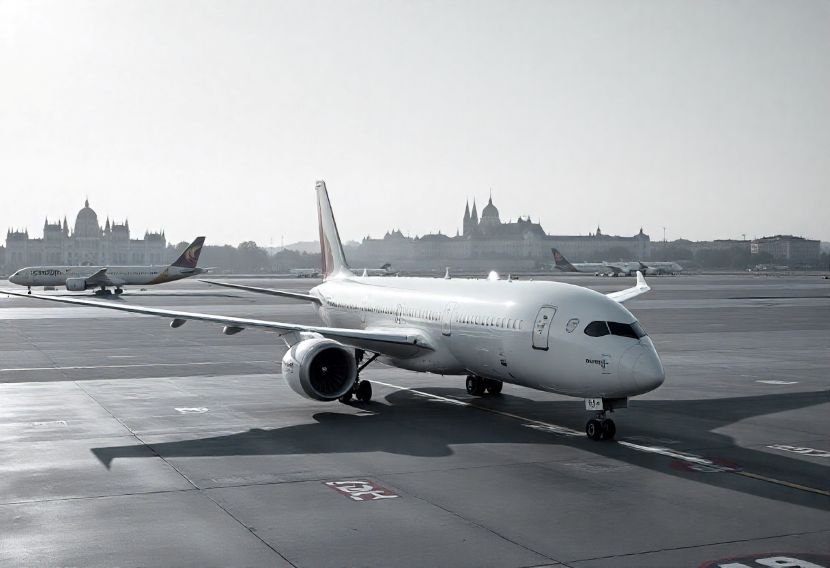Flight Buzz
Thailand aims for remarkable tourism revival attracting Nine million Chinese visitors with expanded flights enhanced safety and irresistible travel experiences

Published on
August 8, 2025 |
By: TTW News Desk
Thailand aims to welcome 9 million Chinese travellers next year—about an 80% rise from this year—by rapidly increasing direct and charter flights from major Chinese hubs, launching targeted marketing and digital campaigns during peak holiday windows, and strengthening safety, emergency-response and public-reassurance measures to address recent security concerns; alongside these moves the government and industry are easing visa and entry procedures, offering airline and tour incentives, and pushing hotels, attractions and service providers to add Chinese-language support, mobile payment options and tailored itineraries. Together, these actions are designed to restore traveller confidence, expand seat capacity and convert demand into bookings, driving higher spending across hotels, retail and transport and helping Thailand reclaim a substantial share of its pre-pandemic Chinese market—provided broader economic and geopolitical conditions remain stable.
Thailand Targets Strong Rebound in Chinese Tourism with Ambitious 2026 Arrival Goal
Thailand, the second-largest economy in Southeast Asia, is preparing for a significant tourism surge as it projects nine million Chinese visitors in the coming year. This represents an estimated 80% increase from this year’s figures and reflects the government’s intensified push to revive its tourism sector. Efforts include expanding charter flight services, launching large-scale promotional campaigns in key Chinese cities, and implementing strategies to rebuild traveller confidence after a challenging period.
The renewed optimism comes at a crucial time for Thailand’s tourism industry, which has faced both economic and reputational hurdles in recent years. The country’s tourism authorities believe that easing travel procedures, strengthening airline partnerships, and enhancing visitor safety standards will encourage a faster recovery in the vital Chinese market. Chinese travellers have historically been Thailand’s largest inbound tourist group, making them essential to the nation’s economic recovery.
One of the key drivers behind this strategic push is the recognition that safety perceptions strongly influence travel decisions. Earlier this year, high-profile reports such as the kidnapping incident involving Chinese actor Xing Xing in January created apprehension among potential visitors. Thai officials are now prioritizing stronger security measures, improved emergency response systems, and public awareness campaigns to reassure both tourists and tour operators.
Tour industry experts in China also see potential for improvement. Zheng Wei, the owner of Gansu Junhe Cultural Tourism in Lanzhou, predicts that the benefits of Thailand’s current initiatives will start showing in the final months of this year. According to market analysis, if no major setbacks occur in the travel environment, Chinese arrivals could recover to between 70% and 80% of pre-pandemic levels by the end of next year.
The recovery path, however, is still uneven. Official statistics show that Thailand welcomed only 2.64 million Chinese tourists in the first seven months of the current year, far below the figures recorded before global travel restrictions began. While the pace of arrivals is gradually picking up, it remains heavily influenced by airline capacity, economic conditions in China, and competition from other destinations in the Asia-Pacific region.
The Bank of Thailand has taken a cautious view in its projections. According to its estimates, Chinese visitor numbers will likely close at around five million this year, marking a decline of roughly 25% compared to last year’s total. This drop reflects the combined impact of economic uncertainty in key markets and shifting travel preferences among younger Chinese tourists, who are increasingly exploring alternative destinations that offer similar cultural and leisure experiences.
Thailand’s broader tourism sector, however, continues to perform strongly in terms of overall visitor numbers. Last year, the country attracted more than 35 million international travellers, of which 6.7 million came from China. Industry analysts note that a full recovery of the Chinese market would significantly boost total arrivals and spending, given the group’s high contribution to retail, dining, and entertainment sectors.
To achieve the ambitious nine-million-visitor goal, Thai authorities are rolling out targeted strategies. Airlines are being encouraged to operate more direct flights from major Chinese hubs such as Beijing, Shanghai, Guangzhou, and Chengdu. Tourism offices are hosting cultural festivals, culinary showcases, and shopping events in partnership with Chinese travel agencies to promote Thailand’s image as a safe, welcoming, and exciting destination.
In addition, Thailand is expanding its digital engagement to capture the attention of China’s tech-savvy travellers. Social media campaigns, influencer collaborations, and online booking incentives are being used to reach younger audiences who rely heavily on mobile apps for trip planning. Special promotions during China’s key holiday periods, including the Lunar New Year and Golden Week, aim to maximise visitor flows during peak seasons.
Tourism-related businesses in Thailand are also adapting to shifting consumer expectations. Hotels and resorts are enhancing Chinese-language services, adjusting menus to cater to diverse dietary preferences, and introducing payment options compatible with popular Chinese mobile wallets. Popular tourist spots are implementing advanced crowd management systems to improve visitor experience and safety.
Market observers point out that the success of this recovery effort will depend on multiple factors, including China’s domestic economic stability, ongoing geopolitical developments, and Thailand’s ability to sustain competitive advantages in the regional travel market. Maintaining affordable travel packages, ensuring convenient visa processes, and providing memorable cultural experiences will be essential in retaining traveller interest.
Thailand’s tourism leaders remain optimistic. They argue that the country’s diverse offerings — from vibrant cities and golden beaches to ancient temples and rich culinary traditions — give it a strong competitive edge. The government’s proactive stance, combined with industry cooperation, could accelerate the rebound and re-establish Thailand as a top choice for Chinese holidaymakers.
If the nine-million target is reached, the economic benefits could be substantial. Increased hotel occupancy, higher spending in local markets, and stronger demand for transportation and entertainment services would support jobs across the hospitality sector and contribute significantly to national GDP. In turn, this could help offset slower growth in other economic areas and strengthen Thailand’s position as a tourism powerhouse in Southeast Asia.
Thailand plans to attract 9 million Chinese visitors next year by expanding flights, boosting safety measures, easing travel processes, and launching targeted campaigns to restore confidence and spending in its vital tourism sector.
While challenges remain, Thailand is moving forward with confidence. The planned expansion of charter flights, intensive marketing campaigns, and renewed emphasis on safety all signal a clear message — the nation is ready to welcome Chinese travellers back in greater numbers. As long as global travel conditions remain stable and visitor trust continues to grow, the coming year could mark a turning point in the revitalisation of this vital tourism link between Thailand and China.
Flight Buzz
Indonesia To Boost Tourism With New Direct International Flights, Bypassing Jakarta

Published on
August 8, 2025 |
By: TTW News Desk
President Prabowo Subianto has challenged the Ministry of Transportation to launch direct international flights to tourist hotspots across Indonesia. Skipping Jakarta as the usual stop, this plan hopes to draw more travelers and larger foreign cash flows, giving the tourism sector and the national economy a meaningful lift.
According to Hasan Nasbi, Head of the Presidential Communication Office, the move underscores tourism as a cornerstone of Indonesia’s revenue base. Prabowo’s vision dovetails with the broader goal of a more balanced economy, placing the tourism industry squarely at the leading edge of growth.
Expanding Air Connectivity for Tourism Growth
At a press briefing on August 7, 2025, Nasbi outlined the President’s roadmap to open flights straight to key tourist markets across the archipelago. The present system, which routes almost all foreign flights through Jakarta, will give way to new links that land in regional airports. The approach is designed to streamline journeys and shine a spotlight on lesser-known destinations beyond the capital.
Prabowo’s announcement shows the administration’s pledge to make air travel across Indonesia easier by letting more regional airports welcome international flights. This step is also part of the plan to help local economies by opening up key tourist spots to visitors from abroad.
The President’s plan zeroes in on tourism’s twin prizes: more money for the country and new jobs for the people. Hasan Nasbi pointed out that travel and tourism produce strong income and draw in foreign exchange, both of which fuel national growth.
The push for direct flights is all about smoothing the travel path for tourists from major markets. With easier access, Indonesia strengthens its appeal on the world tourism stage. By opening up regional air access, the state hopes to shine a light on the country’s hidden gems, spreading the wealth of tourism beyond the big city hubs.
Potential Impact on National Revenue and Employment
The President’s strategy focuses on the dual benefits of tourism: boosting national revenue and creating employment opportunities. Hasan Nasbi noted that tourism plays a critical role in generating significant income and attracting foreign exchange, which are crucial for the country’s economic development. As more tourists visit the regions, the local economy benefits from job creation in the hospitality, transportation, and service sectors.
The direct flight initiative aims to streamline international tourism, attracting more visitors from major markets and enhancing Indonesia’s global competitiveness as a tourism destination. By expanding access to regional airports, the government seeks to capitalize on the potential of Indonesia’s lesser-known tourist spots, spreading economic benefits beyond the major urban centers.
New International Airports and Enhanced Connectivity
Indonesia’s strategy to promote tourism is supported by the recent inclusion of five airports in the list of international airports. This update is part of the country’s broader efforts to strengthen international air connectivity and provide more convenient access to tourist destinations. According to Minister of Transportation Decrees Number KM 26 and KM 30 of 2025, five airports have been added to the list, bringing the total number of international airports in the country to 22. This marks an increase from 17 international airports listed in Decree KM 31 of 2024.
Three of the newly designated international airports include Sultan Mahmud Badaruddin II Airport in Palembang, H.A.S. Hanandjoeddin Airport in Bangka Belitung, and Jenderal Ahmad Yani Airport in Semarang. These airports are now prepared to accommodate international flights and will play an important role in making direct international routes more viable.
Two additional airports, Syamsuddin Noor Airport in Banjarmasin and Supadio Airport in Pontianak, were also granted international status. However, the official designation of these airports remains subject to ongoing performance evaluations. The Ministry of Transportation will assess their viability based on criteria such as passenger and cargo traffic, flight frequency, and infrastructure readiness.
Future Prospects and Evaluations
The government has been busy adding new international airports, but leaders stress the task is far from over. Lukman F. Laisa, the Director General of Air Transportation, said every airport will be watched closely. Authorities will check whether the airport can still manage international traffic by looking at flight demand, how ready the operations are, and whether the airport can safely handle more passengers.
Airports that slip below the needed operational and infrastructure standards will lose their international designation. This careful approach lets Indonesia keep improving its tourism network in step with both local and global travel demand.
Enhancing Regional Economic Growth Through Tourism
President Prabowo’s push for more direct international flights also serves a bigger, economic purpose. Better access to quieter, lesser-visited areas means the wealth brought by tourism can be shared more fairly across the country. Many of the new international airports are in provinces that have beautiful sights and cultural riches but have not yet attracted many visitors. These regions are now perfectly positioned to welcome more foreign guests and boost their local economies.
This plan will give local economies a surge by drawing more international tourists to spots outside Jakarta. More foreign visitors should help local businesses grow, particularly in hotels, restaurants, and services, and will open up many new jobs in those areas.
Indonesia’s Bright Future in Global Tourism
Launching new international flights is key to making Indonesia a top player in global tourism. Direct flights to more regional airports, instead of just Jakarta, lets visitors reach amazing destinations more easily. Each new route not only helps local areas earn more but also brings in valuable foreign currency.
Better global connections should also boost visitor numbers and length of stay. More tourists who stay longer spend more money and explore more corners of the archipelago, driving local economies and reinforcing Indonesia’s place as a must-visit gem in Southeast Asia.
Flight Buzz
Pakistan to arrange special flights, discounted travel to Iraq for pilgrims after land route closure

KARACHI: US President Donald Trump’s move to double tariffs on Indian goods presents a “strategic opening” for Islamabad to deepen its trade partnership with Washington, Pakistan’s finance adviser Khurram Schehzad said on Thursday.
Trump signed an executive order on Wednesday to place an additional 25 percent tariff on India on top of a 25 percent tariff that went into effect on Thursday. The move made India one of the most heavily taxed US trading partners in Asia.
Pakistan, India’s traditional arch-rival, has meanwhile improved its ties with Washington. Pakistan and the US finalized a trade agreement last week under which a 19 percent tariff was imposed on a wide range of Pakistani goods. The new rate marked a considerable reduction from the initially proposed 29 percent under a sweeping executive order signed by Trump.
“The US tariff hike on Indian goods presents a strategic opening for Pakistan,” Schehzad told Arab News.
Washington’s 19 percent tariff on Pakistani goods makes them less expensive than Indian goods, making Pakistan one of the countries with the lowest tariff profiles in the region.
“We see this as a moment of opportunity to deepen trade and economic ties with the United States,” the finance official added.
The US is Pakistan’s largest export destination, State Minister for Finance Bilal Azhar Kayani said on Thursday. He added that out of $32 billion of Pakistan’s exports in the last fiscal year, $6 billion went to the US.
Pakistan’s tariff deal with the US took place at a time when Islamabad is pushing for an economic revival, buoyed by a $7 billion financial bailout package by the International Monetary Fund (IMF).
Pakistan has undertaken financial reforms over the past two years. Prime Minister Shehbaz Sharif has tasked authorities to ensure Islamabad’s $32 billion annual exports surge to over $60 billion by fiscal year 2028-29.
Pakistan, having one of the lowest regional tariff profiles and also attracting a growing US investment interest, is positioned to expand its exports, particularly in textiles, pharmaceuticals, agriculture, technology, mining & minerals, and other value-added manufacturing, Schehzad said.
“This agreement will help us realize the long-term export targets we have set under Uraan Pakistan program,” he said, referring to the government’s economic plan that aims to make Pakistan a trillion-dollar economy by 2035.
‘MAJOR OBSTACLES’
Pakistani businesspersons, especially those related to textiles, think otherwise.
Atif Ikram Sheikh, president of the Federation of Pakistan Chamber of Commerce and Industry (FPCCI), said the US has imposed the lowest trade tariffs in the region on Pakistan, which Islamabad should take full advantage of.
However, he said higher production costs in Pakistan could neutralize this benefit.
“Taxes and high electricity and gas prices for the industry are major obstacles to taking advantage of low tariffs,” Sheikh said.
The textile industry is Pakistan’s biggest foreign exchange earner, fetching $18 billion during the last fiscal year, most of which came from the US.
Kamran Arshad, chairman of the All Pakistan Textile Mills Association (APTMA), was also unsure whether the new trade agreement with the US would benefit Pakistan significantly.
“The costly power and high interest rates would not allow us to compete (in the global textile market) at this 19 percent tariff,” Arshad told Arab News.
Last week, Pakistan’s central bank kept the policy rate unchanged at 11 percent, adopting a cautious approach.
According to the APTMA, Pakistan has a higher interest rate of 11 percent, compared to India’s 5.5 percent, Bangladesh’s 10 percent, Vietnam’s 4.5 percent, Sri Lanka’s 7.75 percent, Indonesia’s 5.25 percent and Cambodia’s 3 percent.
The power tariff for industries in Pakistan, meanwhile, stands at $0.16 kilowatt per hour as compared to $0.096 in India, $0.10 in Bangladesh, $0.08 in Vietnam, $0.06 in Sri Lanka, $0.07 in Indonesia and $0.135 in Cambodia, the data shows.
Pakistani businesses are paying 29 percent corporate income tax and as much as 10 percent super tax compared to the 27.5 percent preferential taxes their competitors from India, Bangladesh, Vietnam, Sri Lanka, Indonesia and Cambodia are paying on incomes.
“Pakistan’s corporate tax, policy rate, labor costs, electricity rate put us at a disadvantage with India, Bangladesh, Vietnam, Sri Lanka and Indonesia,” Arshad noted.
Shankar Talreja, head of research at Karachi-based brokerage firm Topline Securities, said the US is a “big market” for pharmaceuticals, textiles and food products.
“If Pakistan gets preferential treatment in the US market, this will help our companies grow further,” he said.
Flight Buzz
American Airlines Expands Philadelphia’s Reach with New Flights to Budapest and Prague Starting Summer 2026: All You Need To Know

Published on
August 8, 2025 |
By: TTW News Desk
Philadelphia International Airport (PHL) is about to see an exciting new addition to its international flight routes. American Airlines has announced it will begin offering direct flights from Philadelphia to Budapest and Prague starting in summer 2026. The new routes are set to enhance Philadelphia’s growing network of international flights, giving travelers more convenient options to visit two culturally rich European destinations.
A Step Toward More Global Connectivity
With these new direct flights, American Airlines is positioning Philadelphia as a central hub for travelers looking to explore Europe. The airline’s Vice President of PHL Operations, Lakshman Amaranyaka, emphasized that this expansion is part of a broader effort to connect Philadelphia with more global destinations. He stated that the addition of Budapest and Prague will not only provide travelers with access to the unique attractions in Hungary and the Czech Republic but also increase the airline’s offerings across the Atlantic.
Budapest: The Heart of Europe’s History and Culture
Hungary’s capital city of Budapest boasts of its unique thermal baths, stunning architectural sites, and an intriguing historical heritage. The city is also well known for the river Danube which divides Budapest into two parts, Buda and Pest, featuring the grand Hungarian Parliament Building and Buda Castle which along with several other sites offer history, relaxation, and adventure. Travelers from the United States will be pleased with the news that American Airlines is the only airline that offers nonstop flights to Budapest.
Prague: A City of Fairytale Charm
Prague, the capital of the Czech Republic, is known for its iconic medieval architecture, including the famous Prague Castle and the historic Charles Bridge. The city’s fairy-tale atmosphere is complemented by a vibrant cultural scene, with world-class music, art, and food. Prague’s appeal to tourists grows each year, and with this new nonstop service, American Airlines is making it easier than ever for Philadelphia residents to experience the magic of this Central European city.
Expanding European Connections from Philadelphia
This is the third consecutive summer that American Airlines has expanded its European destination offerings from Philadelphia. The airline added Nice, France, and Copenhagen, Denmark to its route network in 2024. This year, Milan and Edinburgh also became directly accessible from PHL. These changes highlight American Airlines’ efforts to further develop its European network and strengthen its position in the international market, thus bringing greater appeal to Philadelphia International Airport.
The flights to Budapest and Prague will operate on Boeing 787-8 aircraft, which offer a comfortable flying experience with advanced amenities. American Airlines will begin accepting ticket bookings for these flights on August 11, 2025. Passengers can purchase tickets on the airline’s website or via the American Airlines app.
PHL’s Continued Growth as an International Gateway
The incorporation of Budapest and Prague further augments PHL’s stature as a global gateway. “Atif Saeed, CEO of PHL, noted the incorporation of these routes would give travelers from Philadelphia added nonstop travel options on a wider selection of as well as popular European stops. The Growth of PHL Airport has been steady over the years, and the new routes represent yet another leap towards establishing it as a primary U.S. hub for international travelers.
American Airlines adding nonstop service from Philadelphia to Budapest and Prague is a boon not only for Philadelphia travelers, but for the wider region as well. The new service is anticipated to help stimulate the local economy as well as create jobs and tourism in both Budapest and Prague. The new routes are expected to generate flights for a diverse array of travelers, including business travelers, tourists, and travelers visiting friends and family.
Premium Experiences for Philadelphia Travelers
In addition to expanding its European flight options, American Airlines is offering new premium services for Philadelphia travelers. For flights to London, the airline has introduced Flagship Suite seats, providing a more luxurious and private flying experience. These seats will also be available for flights to Zurich, starting in September 2025. This enhanced premium experience further underscores American Airlines’ commitment to offering Philadelphia passengers a comfortable and enjoyable travel experience.
Why You Shouldn’t Miss These New Routes
For travelers based in Philadelphia, there are new updates on travel options. New flights add considerable flexibility as you can now directly travel to stunning cities like Prague and Budapest. Accessing these cities is considerably more customer friendly now that the flights are non-stop.
Both Budapest and Prague offer a mix of modern attractions and historical sites, appealing to a wide range of interests. These cities are growing in popularity, and now, with American Airlines offering direct flights, there’s no better time to visit.
Final Thoughts
The expansion of American Airlines’ operations in Philadelphia with the addition of direct flights to both Budapest and Prague opens up even more possibilities for American travelers to visit Europe. The nonstop flights will undoubtedly enhance tourism and business travel to and from Central Europe starting in the summer of 2026. Don’t forget to mark August 11, 2025, on your calendar to purchase tickets for these flights.
-

 Brand Stories3 weeks ago
Brand Stories3 weeks agoBloom Hotels: A Modern Vision of Hospitality Redefining Travel
-

 Brand Stories2 weeks ago
Brand Stories2 weeks agoCheQin.ai sets a new standard for hotel booking with its AI capabilities: empowering travellers to bargain, choose the best, and book with clarity.
-

 Destinations & Things To Do3 weeks ago
Destinations & Things To Do3 weeks agoUntouched Destinations: Stunning Hidden Gems You Must Visit
-

 Destinations & Things To Do2 weeks ago
Destinations & Things To Do2 weeks agoThis Hidden Beach in India Glows at Night-But Only in One Secret Season
-

 AI in Travel3 weeks ago
AI in Travel3 weeks agoAI Travel Revolution: Must-Have Guide to the Best Experience
-

 Brand Stories1 month ago
Brand Stories1 month agoVoice AI Startup ElevenLabs Plans to Add Hubs Around the World
-

 Brand Stories4 weeks ago
Brand Stories4 weeks agoHow Elon Musk’s rogue Grok chatbot became a cautionary AI tale
-

 Brand Stories2 weeks ago
Brand Stories2 weeks agoContactless Hospitality: Why Remote Management Technology Is Key to Seamless Guest Experiences
-

 Asia Travel Pulse1 month ago
Asia Travel Pulse1 month agoLooking For Adventure In Asia? Here Are 7 Epic Destinations You Need To Experience At Least Once – Zee News
-

 AI in Travel1 month ago
AI in Travel1 month ago‘Will AI take my job?’ A trip to a Beijing fortune-telling bar to see what lies ahead | China













You must be logged in to post a comment Login